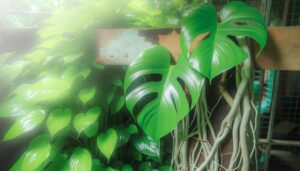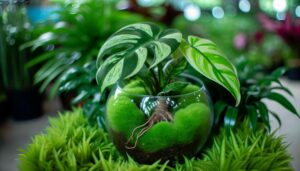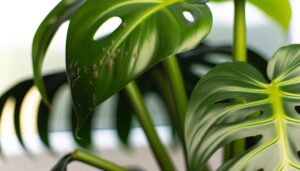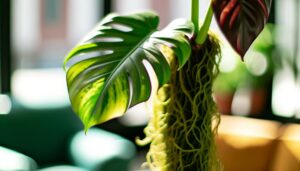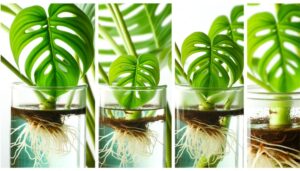Monstera Adansonii in the Wild
In the wild, Monstera Adansonii thrives in the humid tropical rainforests of Central and South America. You'll see it clinging to tree trunks, climbing towards the canopy in shaded environments with filtered sunlight.
It relies on rich organic material on the forest floor and needs high humidity levels over 70% and temperatures between 65°F and 85°F. The plant's fenestrated leaves help optimize light capture, and its climbing behavior creates microhabitats, benefiting local wildlife.
Unfortunately, habitat destruction and illegal plant trade threaten its survival, making conservation efforts critical. Dive deeper to uncover more about this fascinating plant's role and challenges.

Key Takeaways
- Thrives in humid tropical rainforests of Central and South America.
- Uses aerial roots to climb tree trunks and access sunlight.
- Prefers shaded areas under the forest canopy with filtered light.
- Provides habitat and food for birds, insects, and small mammals.
- Faces threats from deforestation and illegal plant trade.
Natural Habitat
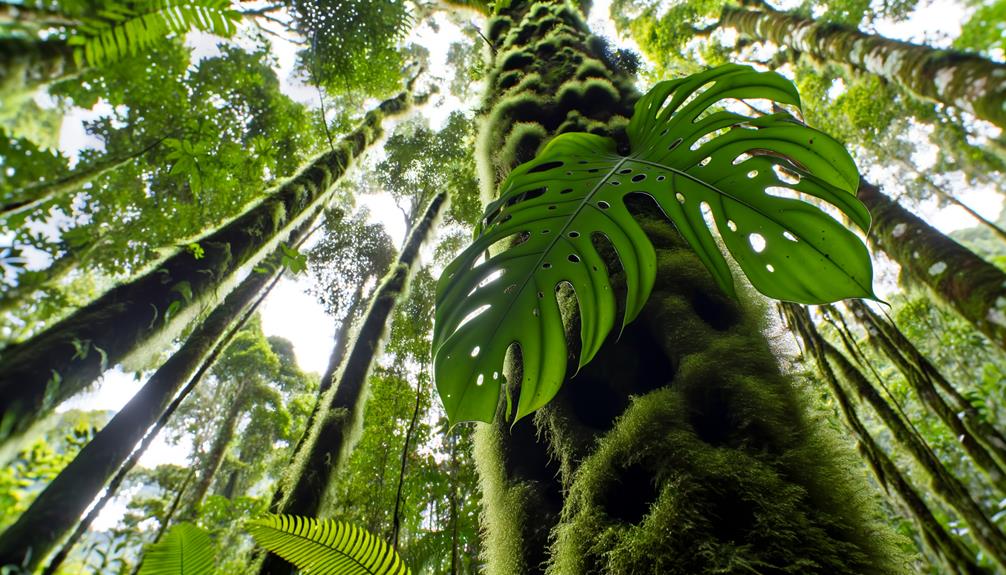
You'll find Monstera Adansonii thriving in the humid, tropical rainforests of Central and South America, where it clings to tree trunks and climbs toward the canopy. This epiphytic plant prefers the damp, shaded environments under the forest canopy, receiving filtered sunlight.
The forest floor's rich, organic material provides the nutrients it needs. High humidity levels, often exceeding 70%, and temperatures ranging between 65°F and 85°F create ideal conditions for its growth. Rainfall is frequent, keeping the soil consistently moist.
The plant's aerial roots latch onto surfaces, absorbing moisture and nutrients directly from the air. Understanding its natural habitat helps you simulate these conditions at home, ensuring your Monstera Adansonii remains healthy and vigorous.
Growth Patterns
Observing Monstera Adansonii in its natural habitat reveals its unique growth patterns, characterized by rapid vine-like expansion and the development of fenestrated leaves. You'll notice the plant's aerial roots anchor it to trees, allowing it to climb and access more sunlight.
This climbing behavior facilitates its vertical growth, often reaching several meters high. The leaves develop characteristic holes, or fenestrations, which increase in size and number as the plant matures. These fenestrations help reduce wind resistance and increase light capture, enhancing photosynthesis.
Additionally, Monstera Adansonii exhibits a heliotropic response, orienting its leaves towards sunlight. This adaptation maximizes energy absorption, essential for its vigorous growth. Understanding these patterns highlights the plant's incredible ability to thrive in dense tropical forests.
Ecological Role
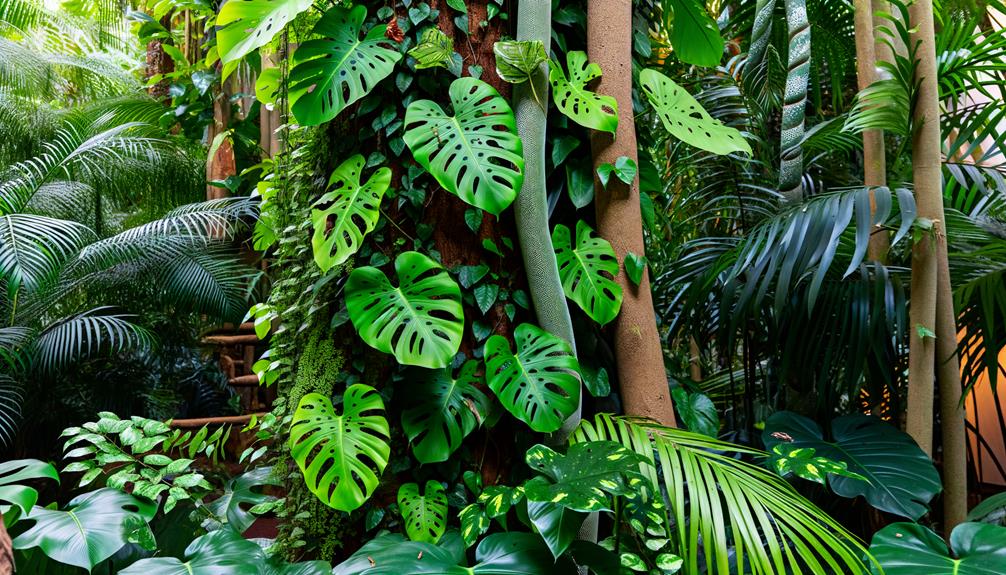
Monstera Adansonii plays a significant role in its ecosystem by providing habitat and food sources for various tropical forest species. As an epiphytic plant, it climbs trees, creating microhabitats in the canopy. Its leaves collect water, benefiting small organisms like insects and amphibians.
The plant's aerial roots latch onto tree trunks, ensuring stability and access to sunlight. This climbing behavior reduces ground competition, enhancing biodiversity. Monstera Adansonii also contributes to the forest's nutrient cycle by decomposing organic matter. Its fruits, rich in nutrients, attract birds and mammals, aiding seed dispersal. By doing so, it promotes forest regeneration.
You'll notice that this plant isn't just a passive participant but an active contributor to its environment's health and diversity.
Wildlife Interactions
In the wild, Monstera Adansonii engages in complex interactions with wildlife, offering both shelter and sustenance to a diverse array of species. You'll find that its leaves and structure provide essential habitats and resources.
- Birds use the broad leaves for nesting, benefiting from the protection they offer from predators.
- Insects thrive on the plant, utilizing it for food and laying eggs.
- Small mammals find refuge within the dense foliage, using it as a hiding spot.
- Frogs are often seen taking advantage of the moisture retained by the plant's aerial roots.
- Monkeys frequently consume the plant's fruit, aiding in seed dispersal.
These interactions underline the plant's integral role in its ecosystem, fostering biodiversity.
Conservation Issues
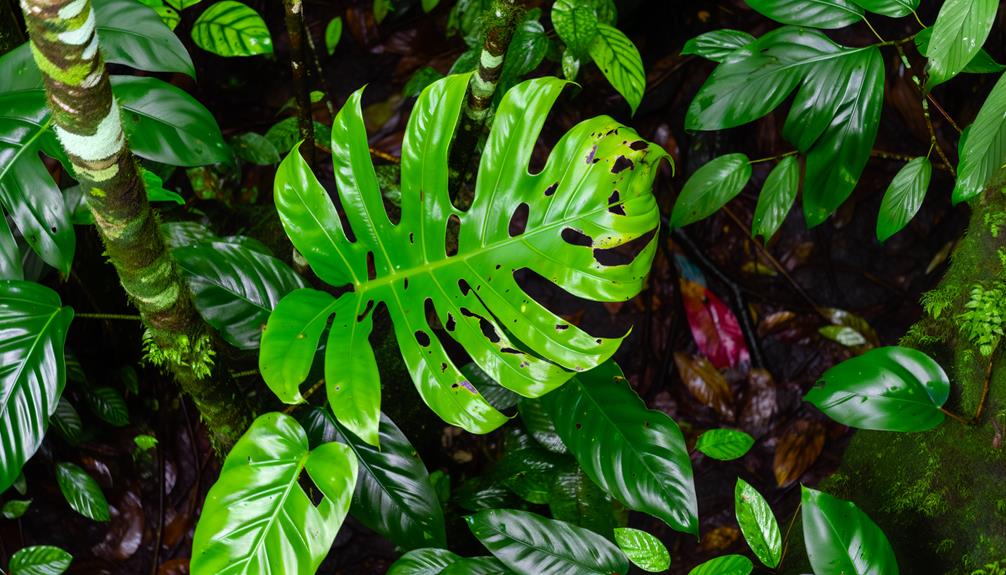
Conservation issues surrounding Monstera Adansonii stem from habitat destruction, deforestation, and the illegal plant trade, which collectively threaten its natural populations.
You'll find that habitat destruction results from agricultural expansion and urbanization, leading to fragmented ecosystems. Deforestation, particularly in tropical rainforests, reduces the availability of the tree canopies that Monstera Adansonii relies on for growth and survival.
The illegal plant trade exacerbates these issues by removing specimens from their native environments, disrupting local biodiversity. Conservation efforts must focus on protecting natural habitats, enforcing stricter regulations on plant trade, and promoting sustainable cultivation practices.
Conclusion
In the wild, you'll find Monstera adansonii thriving like a hidden gem in tropical rainforests, weaving through trees and playing an essential role in its ecosystem. Its unique growth patterns and interactions with wildlife highlight its ecological importance.
However, conservation issues cast a shadow over its future. By understanding and protecting this species, you're not just safeguarding a plant, but a piece of the intricate web of life, ensuring the rainforest remains a vibrant tapestry.

